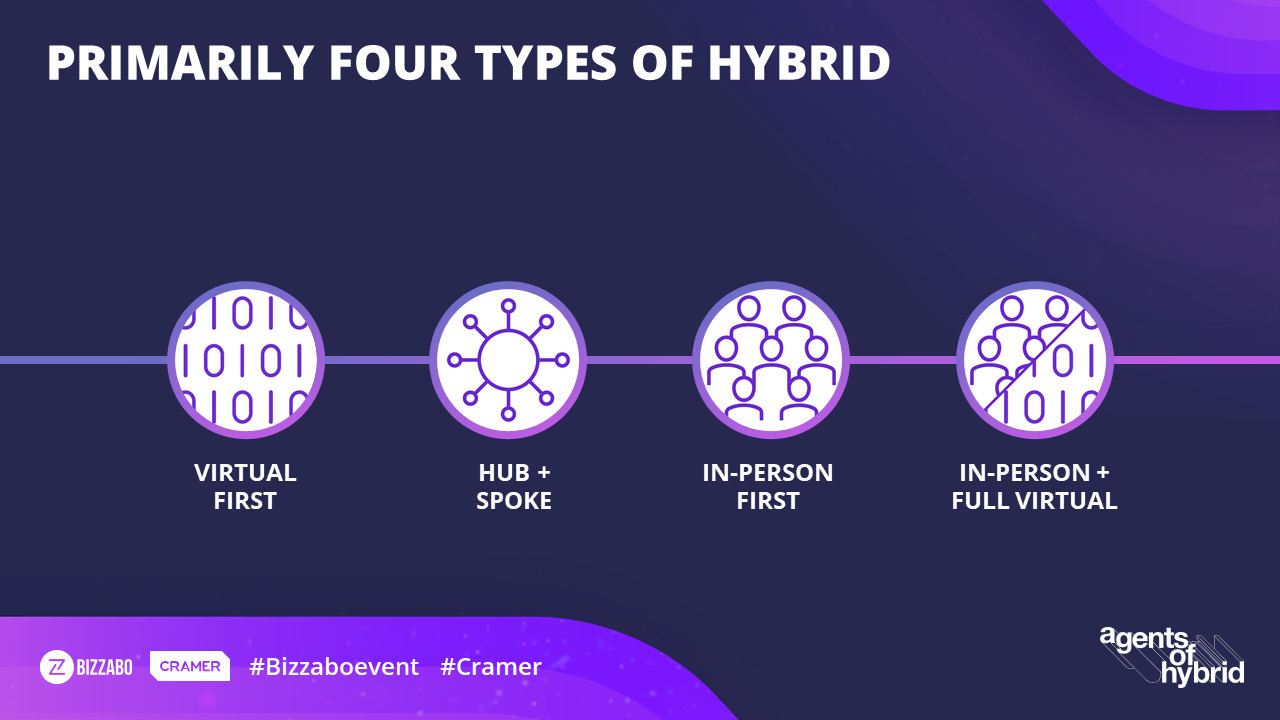Virtual events were a temporary solution, right? So, we thought.
One thing has become clear- virtual isn’t going anywhere. The industry’s transformation to virtual events resulted in better content, increased reach and accessibility, more flexibility for speakers, and extended audience engagement. Event organizers will be expected to deliver on these improvements going forward.
Virtual events, however, fail to meet the need for human interaction. Online it is difficult, if not impossible, to create spontaneous interactions and shared emotions that bring so much energy and value to an event.
So, now what? Organizers are looking for ways to merge the value of both in-person and virtual experiences into one event strategy. Producing a hybrid event experience. But, what the heck does hybrid really mean?
Here are the four production models we expect most hybrid events to follow:

1. Virtual first
In a virtual first hybrid event model, your primary goal is to produce the best experience for your online attendees. There is a single source of content generation, for example, all of your speakers are presenting from the same studio, but the content delivery is aimed at the virtual audience. There may be a small in-person audience, but the goal for this model is increased reach and extended engagement.
Virtual first is the easiest type of hybrid event to plan. It allows for maximum versatility. No matter if there is a storm, a problem at a venue, or a pandemic- the show can still go on. Additionally, the online first model provides the opportunity for people to consume the content in small groups or on their own time, making events more accessible and convenient. It is what many companies are doing now, and it has been working well.
2. Hub and spoke
For a hub and spoke hybrid event production model you have multiple sources of content generation that are aggregated into a single program, and then, sent out in a broadcast to multiple locations. These places can be viewing parties or local offices. It seamlessly combines the high-production value and reach of a virtual first approach with the interactivity and human connection of an in-person first approach.
This model is our favorite as the industry experiments and transitions into combining the best of both experiences. Rather than putting 1,000 people together in 1 room, you can put a few people together in a lot of places. With a hub and spoke hybrid production model be careful not to overcomplicate the matrix of connections and technology behind it. When done well, this could be the most cost-effective way to provide a valuable experience for a large audience.
Spoiler Alert: This may be the future!
3. In-person first:
We have all done it, we all know it works. For the in-person first hybrid event production model, your primary focus is the onsite experience for attendees. You build out the on-site experience and plan to webcast out the content from some or all of the event sessions. Keep in mind, your audience’s expectation of what a webcast is has changed, so that experience must be more robust now.
While the on-site attendee experience is your focus, we need to start thinking about little factors such as “how is the opening video going to play at home? “or “does this venue have strong and reliable internet connection?”. Therefore, production capabilities are going to be super important in executing a successful event. No longer can you fall back on what you used to do.
4. Full in-person and virtual:
Full in-person and full virtual is the hybrid event model for people that want to produce an event with the best of both virtual and on-site experiences. This model gives the greatest opportunity for content. You can provide exclusive content for both the on-site and virtual attendees. Then everyone can explore that content on-demand and at their own convenience after the program.
However, supplying two audiences with information that is enriching could double your costs. After all, you are producing 2 distinct experiences. Complexity looms with this type of hybrid event, but if your top priority is the viewer experience, this can be a worthwhile investment. You will meet the increased audience expectations for convenience and production quality online, while also addressing the craving for human connection at the event.
Pro tip: Ask yourself in your early planning phases “what am I trying to get out of it for each individual audience?”
Hybrid event production is more than just a live component and a virtual component, it`s a combination of experiences and goals. Choosing the right format will be a challenge for the near future, so prepare to be flexible. We are excited to use the next 12-18 months to test and reevaluate. You should too. It will be hard, maybe impossible, to be everything to everyone. So, we recommend trying new things and seeing what works. This is an exciting time in live and virtual events- let`s take advantage of it!



